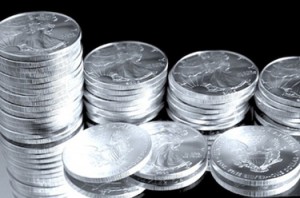
Silver is often treated as a second-class metal when compared to gold, but lately, the smart money is giving silver the first-class treatment. Highly flattering articles are being published in the major financial dailies, and brokers are recommending that clients buy more silver for their portfolios. Along with this, all the traditional fans of silver – sound money proponents, survivalists, and fiscal conservatives – are sounding their trumpets. Yet just because everyone seems to love silver right now, does that mean it’s truly a good idea for you to own?
The True Facts About Silver
Regardless of what is written about silver in the press or on promotional web pages, there are a number of facts about silver that dominate discussions of the metal. Some refer to them as the fundamentals of silver, while others don’t refer to them at all. Yet these facts provide a valuable starting anchor for understanding silver as an investment or safety purchase.
- Silver has served as a unit of money since ancient times. The Bible, ancient Greeks, and Chinese dynasties all reference silver coin as a trusted and valued unit of commerce.
- Silver can only be mined or reclaimed from previously produced items. It can’t be artificially created, which provides a hard limit on supply.
- There are approximately 600 million ounces of silver mined annually, while approximately 800 million ounces of silver are consumed annually.
- The price per ounce for silver in October 2000 was $4.83 on average, and by October of 2010 the price per ounce had moved to $23.86 on the COMEX exchanges.
From these facts, you can understand the basic levers of the silver markets. A history of trust in the metal, an inherently limited supply, and levels of demand that exceed new supply lead to sharp increases in price over time. Knowing the levers, the next important thing to understand about silver is what is driving the high levels of demand. This can help you decide whether the demand for silver is truly sustainable over time, and whether that demand is enough to keep the silver price rising indefinitely.
What Makes Silver Valuable
Silver is valuable for three reasons. It has collectible value, industrial value, and medical value. Each of these areas alone could successfully drive the market, so in combination they are a potent demand structure that keeps the silver price moving steadily higher. Exploring the factors behind each area will help you understand what drives the market.
On the collectible side, there are three main categories of silver collection. The first is the jewelry and art market, whose bracelets, trays, chains, rings, sculptures, and earrings consume an estimated 120 million ounces of silver annually. The second category is rare coin collectors, who primarily buy older silver coins with the intention of holding those coins for personal gain and prestige within their circle of collectors. The third category is silver bullion accumulation, which is primarily done by banks, investment groups, and individuals for portfolio stability, wealth building, and to serve as a hedge against global economic uncertainty.
From an industrial perspective, silver is a highly prized commodity because it is malleable, an electrical conductor, and has no ready substitutes. It can be shaped into almost anything and even broken down into molecules for nanotechnology. As an electrical conductor, this ability to be tiny and move power makes silver a part of cell phones, laptops, digital music players, and other popular consumer goods as well as scientific tools and robotics. Industrial uses consume 60% of the annual production of silver, and without a ready substitute, as long as these goods are in demand silver will be vital for businesses to have.
Last but not least, silver has a number of medical applications. It is anti-fungal, anti-bacterial, and has very few side effects in the human body. Silver salve is used to overcome persistent skin infections, protect the skin of burn victims, and treat bacterial growth. Colloidal silver can be consumed to fight internal infections and harmful bacteria. There are even companies who are weaving silver into fabrics for hospital waiting rooms to fight the spread of germs through casual contact. As long as there are individuals needing healthcare, (and taking into account the coming healthcare usage surge by Baby Boomers worldwide), the demand for silver for medical uses will remain strong.
Looking at these three main demand drivers for silver, it is clear that demand for the metal isn’t going to disappear anytime soon. As a result, investors and collectors of silver can expect to earn a reasonable return on their money. At the very least, those holding silver can rest assured that their metal will never become wholly useless in the eyes of the world’s collectors, businesses, and healthcare groups.
Starting A Silver Collection
Starting a silver collection is actually very straightforward. Silver is one of the more accessible precious metals. It can be bought online and delivered straight to your door, picked up from brick and mortar retailers or coin dealers, traded at local fairs and coin shows, or purchased and held virtually on your behalf. All you need to do to start is determine which kind of silver you would like to use as the foundation of your collection.
The choices are silver bullion or silver coin. Silver bullion is blocks of silver, usually in rectangular slabs or bars that are produced in one ounce, ten ounce, 100 or (rarely) 1,000 ounce increments. Coins can be from any government, in sizes from 1/10th of an ounce up to the dominant one ounce silver coin. The most popular silver coins for the average collector are US silver dollars in the one ounce size, while rare coin collectors often prefer Morgan silver dollars or ancient coins.
Given the ease of acquiring silver, the many demands for the metal, and the sharp price increases over time, it’s no wonder silver is starting to get the first class treatment. This isn’t hot air or a bubble scenario. The factors driving up the silver price – a limited supply and high demand – are measurable and logical. As a result, if you have been looking at silver with a skeptical eye, you now understand why so many people around the world are embracing silver as a smart choice.
Other articles in this issue:
 Off The Grid News Better Ideas For Off The Grid Living
Off The Grid News Better Ideas For Off The Grid Living



